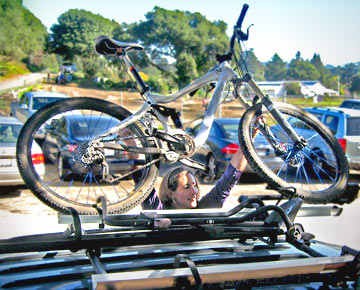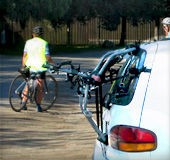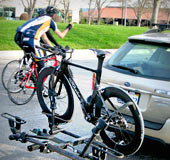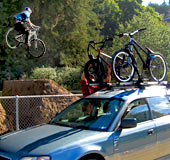Buyer's Guide To Car Racks
 Transporting your bicycle by car is a great way to expand your cycling adventures. It makes it easy to find traffic-free roads, memorable trails, to take your bikes on vacation, or just head over to a friend's house across town for a fun group ride.
Transporting your bicycle by car is a great way to expand your cycling adventures. It makes it easy to find traffic-free roads, memorable trails, to take your bikes on vacation, or just head over to a friend's house across town for a fun group ride.
While on most vehicles, you can simply haul your two-wheeler in the trunk or back seat, this usually requires removing wheels. And, even if you have a roomy SUV that allows toting the bike without disassembly, there's still the risk of chain lube or grease staining that rich Corinthian Leather interior. Plus, with bikes in the back, there's a lot less room for your riding buddies and other gear.
For these reasons, if you drive to bike regularly, you'll appreciate how recent innovations in rack technology have made it much easier to bring your bike(s). Here we go over the major types to help you select the right one.
Basic Considerations
When looking for a rack for your car know the type of vehicle you'll mount the rack to. Consider how many and what types of bikes you plan to carry. Also think about any other gear, such as skis, snowboard, surfboard or kayak equipment. And, determine how far and over what type of terrain you'll drive (dirt roads, etc.). All of these things help determine the best rack for you.
Obviously, not all vehicles are compatible with all types of car racks. For example, you wouldn't want a roof rack on a tall truck or on your convertible. However, in almost all cases, we can find a rack to fit your vehicle and satisfy your mobile cycling needs.
Trunk-Mount Car Rack The first and most basic car-rack type is called the trunk-mount because it fits on trunks or hatchbacks. Consisting of movable locking arms and hooking straps, trunk racks can be adjusted to fit most vehicles, accept 2 to 4 bicycles, and fold for flat storage when not in use.
The first and most basic car-rack type is called the trunk-mount because it fits on trunks or hatchbacks. Consisting of movable locking arms and hooking straps, trunk racks can be adjusted to fit most vehicles, accept 2 to 4 bicycles, and fold for flat storage when not in use.
These racks are portable, low cost, easy to mount to the car and remove, and easy to put bikes on. Drawbacks include having something resting on your vehicle (contact points are protected by pads, however, you might prefer nothing touching your paint job). You’ll also have to remember to fine-tune the straps during installation and before every trip to ensure that the rack is securely attached and can't budge.
Hitch-Mount Car Rack
The next is the hitch-mount. These racks come in all price points and fit into the hitches (also called "receivers") welded onto the frame on the rear of many SUVs, trucks and some cars (if you don't have one, one can be installed). This is a secure connection that ensures that the rack cannot shift or move when you're cruising down the road. And, because these racks hold the bikes and rack away from the vehicle, you don’t have to worry about paint scratches.
These racks come in all price points and fit into the hitches (also called "receivers") welded onto the frame on the rear of many SUVs, trucks and some cars (if you don't have one, one can be installed). This is a secure connection that ensures that the rack cannot shift or move when you're cruising down the road. And, because these racks hold the bikes and rack away from the vehicle, you don’t have to worry about paint scratches.
Available in 2-, 3- or 4-bike models, many of these racks also fold away from the vehicle allowing use of the tailgate or rear door without removing the bikes. Hitch racks can be locked to the hitch for theft prevention and may be easily removed for storage when not in use. The easy-access height makes them the best option for taller vehicles where a roof rack would be challenging to use. The only drawback is that you need to be aware of the rack when backing up since it protrudes.
Roof-Mount Car Rack
The most visibly striking, versatile and expensive type of rack is the roof-mount. Add one of these to your vehicle and you proclaim to the world, “I am an outdoor enthusiast!” Consisting of two crossbars attached to the roof via specially designed towers, these racks can be outfitted to carry bikes, skis, snowboards, canoes, even cargo boxes, securely and safely (cargo boxes are clamshell-like storage trunks that mount to roof rack).  There are roof-rack models that tote just about every bike however you want to carry it (with or without wheels, for example).
There are roof-rack models that tote just about every bike however you want to carry it (with or without wheels, for example).
Roof racks are usually best for carrying tandems and long-wheelbase recumbents, too. And, they can be accessorized with locking towers and bike mounts, and wind fairings. By stowing your bikes and sporting gear on the roof, the full functionality of your vehicle is retained. And, while many users choose to leave them mounted, roof racks can also be removed and with a few small parts, used on different vehicles, too.
There are a few drawbacks to roof racks. You’ll have to be diligent to not forget that your gear is on the roof when driving into your garage and passing beneath low overhangs. Here you must exercise caution because you can seriously damage the bikes and vehicle if you forget.
Also, the aerodynamics of your car decreases with the more gear you carry. Over long road trips you may notice your car is slightly less fuel-efficient. Lastly, lifting gear onto the top of tall cars can be cumbersome for shorter folk. Before you go with a roof-rack option, make sure you can lift your bike above the roof of your car, or else you'll want to bring along a small stepladder.
There is an exception to the reduced aerodynamics of roof racks. If you use a cargo box on your roof rack, tests have shown that it can actually reduce wind drag and increase your fuel efficiency. In fact, with a roof rack and cargo box, a small vehicle can usually carry as much (or more) gear than an SUV while saving you a bundle on fuel costs.
Options For Trucks
The ideal place to carry bikes in a pickup truck is in the bed. If it's just one or two bikes and your bed is large enough, you may be able to simply lay them in the bed in such a way that they don't bump into each other and stay put. For more bikes, there are rack models that fit inside the bed (and
other vehicles with beds, like vans) that hold the bikes upright and in
place.
Another type of truck rack fits over the rear-mounted spare tire. These are designed like trunk-mount racks with arms to support the bikes and straps for easy attachment to, and removal from your vehicle.
People with pickup trucks, and especially those shuttling bikers up and down mountains for downhill runs love padded tailgate covers. They're a simple, quick way to load up your truck with bikes, and depending on the truck size, it’s possible to get up to six bikes in the back. The padded cover simply straps around your tailgate and you place the front wheels over the tailgate with the remainder of the bikes in the bed of the truck.
it’s possible to get up to six bikes in the back. The padded cover simply straps around your tailgate and you place the front wheels over the tailgate with the remainder of the bikes in the bed of the truck.
For the most part the bikes will rest securely on the tailgate. However if you’re going on a long road trip or driving on bumpy roads, you’ll want to strap them down. These covers are a quick and inexpensive way to load up big bikes. However, you’ll have to be careful that the bikes are spaced out adequately or strapped down to prevent them bumping into and scratching each other.
It all goes to show that pretty much whatever type of vehicle you drive, we can help you find a great way to carry your bikes.
Ready To Roll
Just stop by and ask us to help you find the rack that’s best for your needs and vehicle. And don’t worry, our experienced technicians are available to explain how to use your new rack, too. Just ask. See you at the trailhead!
